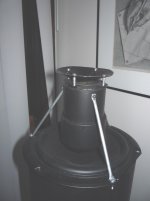Update....
The omnis are in back channel service, and do quite well there. Their ability to not reveal their location is a very good feature for this. Not a bad feature for front channels, either, but as mentioned earlier, I elected to keep dipoles up front so that I could orient them cross-axis for a wider sweet spot.
I've since ran across an extensive thread over at HTGuide that I managed to never find when I had previously google searched all over for info about omnis.
HTGuide Forum - Omnidirectional Speaker Project, any interest, help?
Dan N went to a lot of effort in this (and some later omni designs) and some similar but more extensive research into reflectors. He ended up going a different way and didn't use reflectors on the tweeters and faced them forward, as did Linkwitz. Part of his reasoning was the difficulty in getting a flat response and merging with midrange/woofer, but that also followed from his early decision to not use active crossovers. I personally can't see any reason to not go active these days, small or even large amps of very high quality are cheap and easy to come by and active analog filters are really not very difficult to design. And if design of analog circuits is beyond ambition, then digital crossovers/EQs are pretty reasonable to come by, too.
I'd like to hear his designs some time, but don't have any regrets at all about going with my approach (which was to take the inherent omni-axial pattern as a given and work to find an arrangement to give the best vertial pattern as well, and then eq whatever response comes out of it). Dan N was also concerned about efficiency and SPL, but I suspect he maybe listens louder than I do. I still may make another pair for the fronts, they do sound better in the highs, I think, than do the line dipoles.
-bw
The omnis are in back channel service, and do quite well there. Their ability to not reveal their location is a very good feature for this. Not a bad feature for front channels, either, but as mentioned earlier, I elected to keep dipoles up front so that I could orient them cross-axis for a wider sweet spot.
I've since ran across an extensive thread over at HTGuide that I managed to never find when I had previously google searched all over for info about omnis.
HTGuide Forum - Omnidirectional Speaker Project, any interest, help?
Dan N went to a lot of effort in this (and some later omni designs) and some similar but more extensive research into reflectors. He ended up going a different way and didn't use reflectors on the tweeters and faced them forward, as did Linkwitz. Part of his reasoning was the difficulty in getting a flat response and merging with midrange/woofer, but that also followed from his early decision to not use active crossovers. I personally can't see any reason to not go active these days, small or even large amps of very high quality are cheap and easy to come by and active analog filters are really not very difficult to design. And if design of analog circuits is beyond ambition, then digital crossovers/EQs are pretty reasonable to come by, too.
I'd like to hear his designs some time, but don't have any regrets at all about going with my approach (which was to take the inherent omni-axial pattern as a given and work to find an arrangement to give the best vertial pattern as well, and then eq whatever response comes out of it). Dan N was also concerned about efficiency and SPL, but I suspect he maybe listens louder than I do. I still may make another pair for the fronts, they do sound better in the highs, I think, than do the line dipoles.
-bw
Larger pic of Driver/Reflectors?
Hi -- I like your approach -- I've also thought active electronics could better enable us to take advantage of some of the (potentially) inherent characteristics omni radiation.
Could you possibly post a larger pic of the woofer/tweeter configuration you used? I'm finding the black-on-black a little difficult to make out on my monitor.
THanks, JF
Hi -- I like your approach -- I've also thought active electronics could better enable us to take advantage of some of the (potentially) inherent characteristics omni radiation.
Could you possibly post a larger pic of the woofer/tweeter configuration you used? I'm finding the black-on-black a little difficult to make out on my monitor.
THanks, JF
The omnis are in back channel service, and do quite well there. Their ability to not reveal their location is a very good feature for this. Not a bad feature for front channels, either, but as mentioned earlier, I elected to keep dipoles up front so that I could orient them cross-axis for a wider sweet spot.
I've since ran across an extensive thread over at HTGuide that I managed to never find when I had previously google searched all over for info about omnis.
HTGuide Forum - Omnidirectional Speaker Project, any interest, help?
Dan N went to a lot of effort in this (and some later omni designs) and some similar but more extensive research into reflectors. He ended up going a different way and didn't use reflectors on the tweeters and faced them forward, as did Linkwitz. Part of his reasoning was the difficulty in getting a flat response and merging with midrange/woofer, but that also followed from his early decision to not use active crossovers. I personally can't see any reason to not go active these days, small or even large amps of very high quality are cheap and easy to come by and active analog filters are really not very difficult to design. And if design of analog circuits is beyond ambition, then digital crossovers/EQs are pretty reasonable to come by, too.
I'd like to hear his designs some time, but don't have any regrets at all about going with my approach (which was to take the inherent omni-axial pattern as a given and work to find an arrangement to give the best vertial pattern as well, and then eq whatever response comes out of it). Dan N was also concerned about efficiency and SPL, but I suspect he maybe listens louder than I do. I still may make another pair for the fronts, they do sound better in the highs, I think, than do the line dipoles.
-bw
Hi BW,
I don't frequent this forum much and just happened on this thread. If you have seen some of my other omni or hybri omni designs, here are some links to threads below. I've done about 5 different omni projects, most of which I would call hybrid omni's. One reason for that approach is that one of the critisizms one often hears of true omni's is the lack of imaging. Transitioning to a front firing tweeter that covers much of the frequencies where that the ear uses to locate sounds (2-6khz, IIRC) can provide the best of both worlds. You've already found my first omni design over at HTGuide. Here are the rest.
HTGuide Forum - H.o.s.s.
HTGuide Forum - Introducing the SoundRounds
HTGuide Forum - Sneak Peek: The Duo’s
HTGuide Forum - The Mentor II: omnidirectional project #2
I pushed that concept to its max in my SoundRounds design (second link), which crosses over to a front firing tweeter up around 4khz and uses very small flange neo tweeter with vitually no baffle, so it never really transitions to 2pi space until very high in frequency. Below is what the FR looked like in that design. They won their class at the IowaDIY and imaging and soundstage were their highest rated categories.
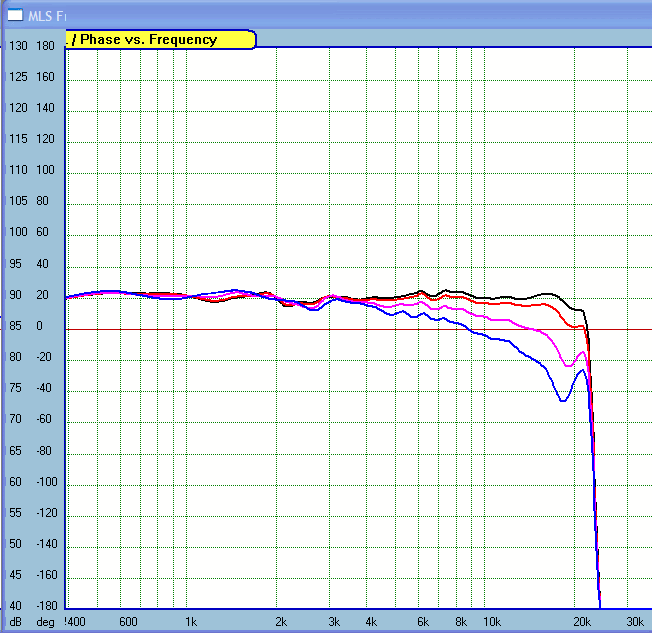
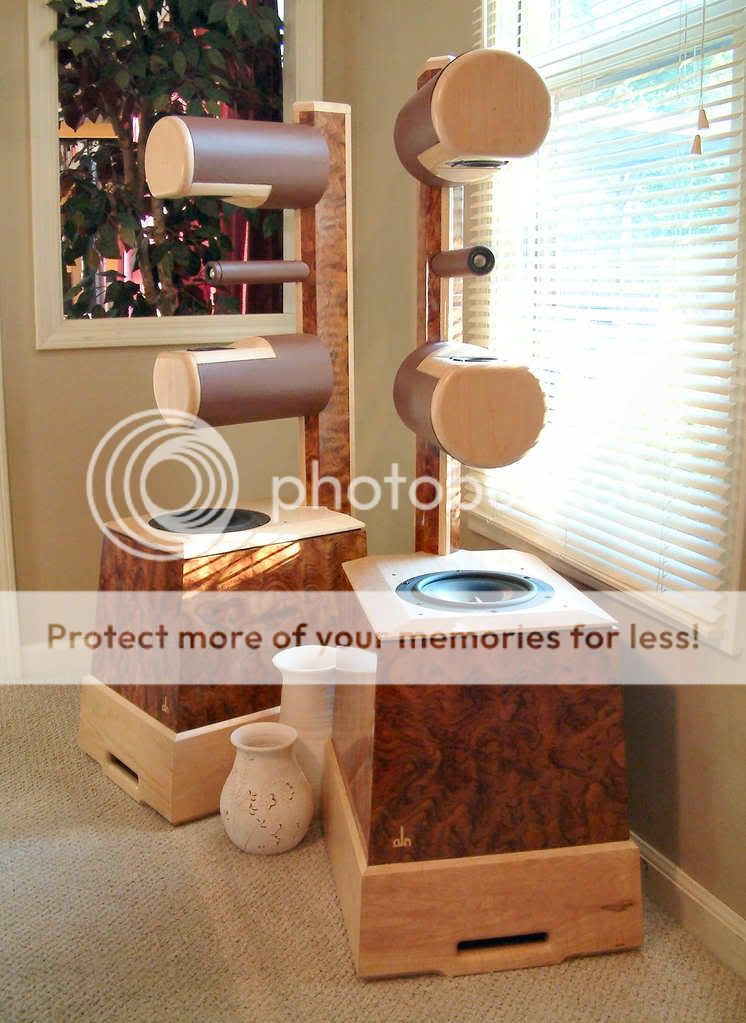
The last link posted is to a design that never made it to a finalized pair, though it was a true omni, much like what you are working on, but a 3way. They came to be know as the waveguide omni's. I didn't finishe them because I was never happy with the midrange, which I have since learned was perhaps the driver, since I have yet to hear a speaker with that midrange that sounded great to my ears. My research has suggested to me that only concave cone deflectors really work well and that all the other shapes are less desirable. Here is a photo of the Waveguide omni's. The have an up and down firing 8" woofer on the bottom, a 2" dome midrange in an 8" waveguide firing up into a concave cone which houses a tweeter in a 6.5" waveguide firing up into another, smaller concave cone. This speaker I think would have a lot of potential with a different dome midrange or perhaps a small cone instead of the dome.
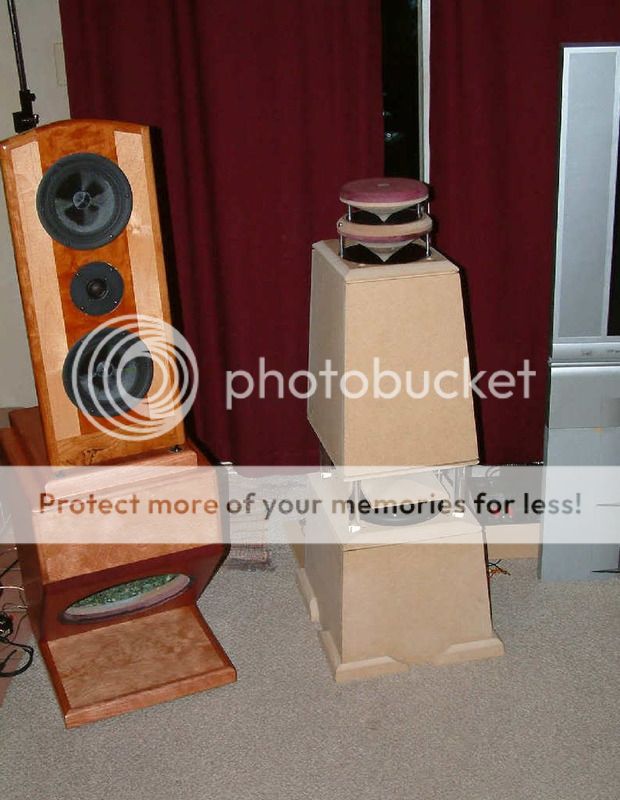
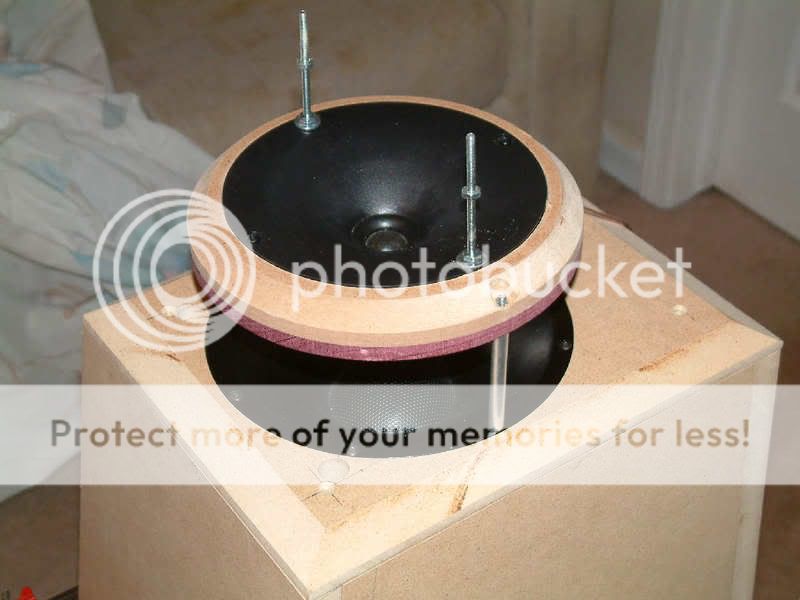
Digeridoo, here is a closeup shot of the tweeter short pipe. Black on black doesn't photograph very well, sorry about that.
Dan N, I have read further about your other designs, very thorough work there. I'd be interested to hear how it goes if you do decide to work again on the midrange of your 'true omnis'. I'm considering doing a half omni, with forward facing tweeter like yours, for a center channel speaker. It has to be up against a wall, anyway, so there's no sense in having that one, at least, radiate more than 180 degrees. I have to deal with how it will play over the video screen, though, not sure how to attack that.
Your SoundRounds do look like an effective design, sort of like a Pluto done in a D'Appolito arrangement! Amazing you got it to go with a passive crossover arrangement, I'm impressed. You should consider marketing that one (though that's a tough path to go down).
Dan N, I have read further about your other designs, very thorough work there. I'd be interested to hear how it goes if you do decide to work again on the midrange of your 'true omnis'. I'm considering doing a half omni, with forward facing tweeter like yours, for a center channel speaker. It has to be up against a wall, anyway, so there's no sense in having that one, at least, radiate more than 180 degrees. I have to deal with how it will play over the video screen, though, not sure how to attack that.
Your SoundRounds do look like an effective design, sort of like a Pluto done in a D'Appolito arrangement! Amazing you got it to go with a passive crossover arrangement, I'm impressed. You should consider marketing that one (though that's a tough path to go down).
Attachments
...
I pushed that concept to its max in my SoundRounds design (second link), which crosses over to a front firing tweeter up around 4khz and uses very small flange neo tweeter with vitually no baffle, so it never really transitions to 2pi space until very high in frequency. Below is what the FR looked like in that design. They won their class at the IowaDIY and imaging and soundstage were their highest rated categories.
...
Hello Dan,
i like your SoundRound design everytime i see it, for one can even
see that it works. Unfortunately i am over the sea.
What is your experience when placing it in different rooms ?
Much tweaking necessary ?
Kind Regards
Hello Dan,
i like your SoundRound design everytime i see it, for one can even
see that it works. Unfortunately i am over the sea.
What is your experience when placing it in different rooms ?
Much tweaking necessary ?
Kind Regards
Hi Oliver,
Thanks for the nice comments! I have found them to be quite flexible from room to room.
I've had them in two different hotel conference rooms for the Dayton and InDIYana DIY's and also in an Auditorium at the Iowa DIY event and they sounded pretty much the same. In all cases, they were well away from any walls.
Of course, like any omni, the clarity degrades as you get too close to the walls and first reflections reach your ear too soon.
I'm contemplating going back to my roots and doing another omni design again (it's been a couple years now since the last one). I just have to settle on what concept to pursue of a couple I have been thinking about and be prepared to do a bunch of new testing again.
BTW, there were a couple omni projects at the Dayton event this year, now called the Midwest Audio Fest, and both sounded very nice in that conference room. One was BWaslo's, but unfortunately he had a problem with one of them and could only play one. You could hear the potential it had, however. The other was based on some used Ohm drivers that had been purchaced from Ebay. It also sounded great.
I'm contemplating going back to my roots and doing another omni design again (it's been a couple years now since the last one). I just have to settle on what concept to pursue of a couple I have been thinking about and be prepared to do a bunch of new testing again.
i have some JBL Aquarius 4 acoustic lens assemblies (these are for the LE8t and the LE20 tweeter) and one pair of the woofer lens from the Aquarius 2 for the 12" woofer.
- Status
- This old topic is closed. If you want to reopen this topic, contact a moderator using the "Report Post" button.
- Home
- Loudspeakers
- Multi-Way
- A 2-way Omni experiment
